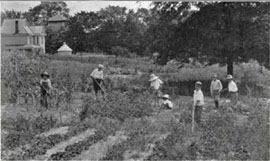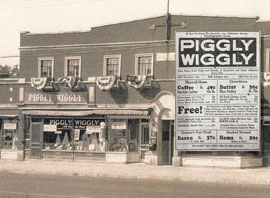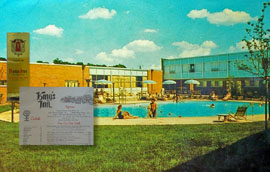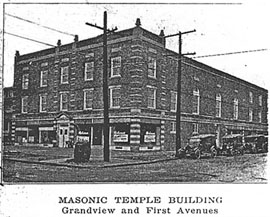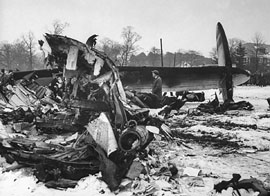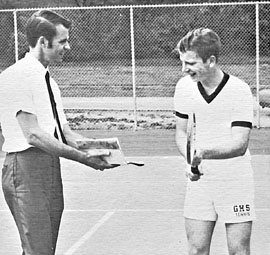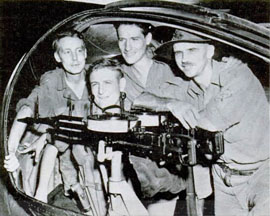This photograph is from the August, 1918 Norwester magazine. It depicts Grandview school children working in the school-sponsored gardens at the corner of Third Avenue and Arlington Avenue. During the first and second world wars, the government encouraged the development of personal and community gardens as a way of focusing on rationing and also building community togetherness. Grandview had a community Victory garden at Goodale and Grandview Avenue, and the school PTA sponsored student gardens in this location. The eighty school kids each had a 10’x30’ plot that they were responsible for maintaining. They set up their lots as a “company” under the direction of the high school principal P.A. McCarty. The “officers” of the company were students Leroy Hendershott (Captain), Marian Hall (First Lieutenant), and Jean Marchi (Second Lieutenant). They planted and grew potatoes, lettuce, beans, onions, and cabbage. The harvest was donated to the community food kitchen kitchen on First Avenue, where the vegetables from the community garden and the school garden were prepared into community meals.
Col. George D. Freeman (inset) was one of Grandview's esteemed turn-of-the-century residents, and was well known throughout Columbus as a businessman and decorated military officer. Born in 1842, he worked in dry-goods and furniture before starting the George Freeman Mantel Co. in 1890. In his military role, he commanded the 14th Regiment of the Ohio National Guard, which was called up by the governor in 1884 to quell a destructive riot in Cincinnati, during which the Hamilton County Courthouse was burned. This call-up resulted in two guardsmen being killed by rioters, and at least a half dozen rioters killed by the guard troops. He later served as the Quartermaster of the Ohio State Arsenal. Freeman’s home, shown here in a 1904 photo, remains on the northwest corner of Goodale Blvd. and Urlin Ave. and was called "Spring Oaks" by he and his wife Julia Ann. After his death, his daughter Julia (Tynan) lived in the house. His son Harry Freeman lived in a home just north of him at 1051 Urlin, which was on the 2004 Historical Society tour.
The Bank Block in Grandview was built in 1928 by Columbus developer Don Casto. Built as a unique shopping center, it flourished for several decades until the development of enclosed shopping venues started its decline. In the mid 1970s, the complex was facing demolition, primarily due to the neglect of the property by its absentee landlords, a Methodist Church in Cadiz, Ohio. In 1977, brothers Mike and Tom Wagenbrenner bought the buildings from the church with the intent of reviving the property. One of the initial tenants was located in the south end of the complex - a delicatessen started by Hubert and Helga Siefert named the Gourmet Market. Initially, the market was a small storefront deli that also did some catering and sold bread, cheese, and upscale deli items. At the time, there was no liquor license available, so Hubert and Helga went door to door in the community to lobby for a vote to allow the sale of alcohol with the goal of expanding to a restaurant. They were successful, and added a restaurant to the market. Eventually they added a second dining area and outdoor seating (shown in this photograph) and rebranded it in 1991 as Spagio. The Wagenbrenner brothers have been lauded as being instrumental in the saving of the Bank Block and the resulting popularity and success of the Grandview Avenue strip. They have in turn given a great deal of credit to the Sieferts for believing in their concept and opening the Gourmet Market. Tom Wagenbrenner died Feb. 24 at OSU’s James Cancer Hospital and Solove Research Institute at the age of 80.
Huntington National Bank was established as P.W. Huntington & Co. in 1866 at Broad and High in downtown Columbus. In 1905 it became Huntington National Bank. The bank acquired many other local banks throughout the early part of the new century, and was one of the first banks to establish branch offices in distributed locations. This 1968 photo shows Huntington officials and Mayor Joseph Wyman (second from left) of Grandview Heights and Mayor Richard Broughton (second from right) of Upper Arlington breaking ground for the Tri-Village branch at 1555 West Fifth. The bank purchased the property from Ruth and Jack Strader, owners of multiple Strader’s Garden Centers around Columbus. While ATMs were first used at Chemical Bank in New York in 1969, HNB was the first bank in the nation to incorporate ATMs (theirs was known as Handy-Bank centers) into an integrated 24-hour fully automated access system. One of the earliest such Handy-Bank systems was at this branch location in Grandview.
The Piggly Wiggly grocery store ( the company founded in Memphis, Tennessee in 1916 by Clarence Saunders) opened it's doors in the Bank Block on Grandview Avenue in Grandview Heights in 1927. The then new Bank Block shopping center, with parking behind the shops, provided the newest conveniences to shoppers, such as the “self-service" opportunity offered by Piggly Wiggly. Until Saunders promoted this method of shopping, customers presented their orders to clerks who gathered the goods from the store shelves. His approach had customers entering through a turnstile and picking out their own items, which were brought to a checkout location. According to the company, Saunders was coy about the origin of the Piggly-Wiggly name. One story says that, while riding a train, he looked out his window and saw several little pigs struggling to get under a fence, which prompted him to think of the rhyme. This photo shows the storefront in the Bank Block (to the left of the Grandview Market grocery store, where the L’Aubergine dining facility currently is located) and a 1930s ad for the stores in the area.
Sylvio Casparis was one of the pioneer residents of Marble Cliff, originally building what was later the convent at Our Lady of Victory Church as his home. Casparis made his fortune from the Casparis Stone Company (founded in 1892) that mined the quarries west of Marble Cliff. In 1907 he purchased a 5-acre tract in the Price/Griswold Arlington Place subdivision, and the next year began construction on a Frank Packard designed Jacobean style mansion. The large residence was patterned after a Scotiish Castle, and was built on the highest point of the land overlooking the Scioto River and the quarries that his company worked. It is reported that Casparis built the mansion for his English-born wife, and that she was never happy living in it. In a 2009 interview, local resident Theresa Magi Frabott related that she and her two older sisters were invited into the kitchen of Casparis Castle, and Swiss-Italian Casparis paid them fifty cents to sing Italian children’s folk songs, despite the objections of his English wife. In 1978, the mansion, tall carriage house, and the surrounding property was converted to condominiums, known as 10 Arlington Place. This photo shows south end of the Castle , looking north from the Arlington Country Club property. The photo was featured in the King Thompson published Country Club District brochure that was used to publicize the development of what would become Upper Arlington.
Murray City Coal and Ice Company was located near Olentangy River Road and Fifth Avenue on Edgehill Road. It was for years co-located with the Boulevard Lumber Company, which was started in 1917 by Henry Miller. The owner of Murray City was Charles H. Boardman, who was active in Marble Cliff politics and activities. This photo shows a fan that was used to promote the company, which Boardman bought in 1919. The photo at the lower right shows the "tipple" that was designed and built by Mr. Boardman, who was a civil and mining engineer by trade, to clean and load coal into the self-dumping Packard delivery trucks or horse-drawn wagons that would move the coal to households in the region. Murray City was one of the most prominent coal suppliers in Columbus, and was connected to some of the largest mines in Ohio and West Virginia. It was the first business to be established in Grandview.
This 1923 photo shows a new "Good Maxwell" motor car, owned by Ira Stanton Jones, who was a teacher and the coach at Grandview High School. The Maxwell was built and sold by the Maxwell Motor Corporation, which was started in 1903 by Jonathan Maxwell and Benjamin Briscoe. The 1923 Maxwell roadster sold for $885, which adjusts with inflation to approximately $9775 today. They built the Maxwell until 1926, when the company became the Chrysler Corporation. In the background is the Grandview School (now called Edison) and a temporary white building that was used during construction of the current high school. This building was moved to the new school property at first and Oxley, and was used as a "portable" building while R. L. Stevenson Elementary School was built.
The Arlington Arms Motel (later known as the Imperial House Arlington) was located just west of Marble Cliff at 1335 Dublin Road (Route 33). The 160-room motel included a popular restaurant, the Kings Inn (sample menu shown in the inset, along with an image of a matchbook from the motel), and the Silver Chalice Lounge. The motel was used to house the Ohio State University football team on the night preceding home games for many years, and was frequently visited by Coach Woody Hayes and other OSU faculty and staff. It was also the site of the Life Member Convention of the American Motorcycle Association (AMA) in the mid-1980s. The AMA was headquartered in Westerville. The motel and restaurant closed in the late 1980s and was replaced by the Riversedge offices and retail outlets. This image is from a Dexter Press postcard published in the mid-1960s.
Because of the rich layers of stone in the region around Grandview, there have been working quarries for many years. Everything from stone slabs that were used in the construction of notable buildings, such as the Statehouse, stones for fences up and down roads like Riverside Drive, to aggregate used in some of the first asphalt roads in the area, tons and tons of rock has been moved from the area. The Marble Cliff Quarry on the west side of the community also used rock crushers, many built by the Jeffrey Mining Machinery Company in Columbus, to process stone into uniform sized gravel, stone, and powder that was used in manufacturing and macadam road covering. Some of the crushed stone products were immediately loaded onto train cars for shipping to the customers, and some was stored in piles to be shipped later. This photo shows limestone being unloaded from a transport car using a quarry steam shovel. The locomotive in the photo is the famous MCQ engine #10, a classic saddle tank engine. More information about these trains can be found at the columbusrailroads.com website.
Freemasonry is the oldest fraternal organization in the world. Founded in London, England in 1717, its current worldwide membership totals 3.6 million members, 1.6 million of which are in North America. Ohio has 120,000 Masons and 530 local Lodges, making it one of the largest Masonic memberships of any state in the country. Community Lodge No. 684, F. and A. M. was chartered in Grandview Heights in 1922 with a charter membership of exactly 100 members, and the Masonic Temple was located at the corner of First and Grandview Avenues. According to a 1923 brochure by the H.E. Dusenberry Realty Co. “The handsome new two-story steel, concrete and brick block covers 65 by 130 feet in this growing section. The lodge has the largest and most beautifully furnished quarters of any blue lodge in this section. The lodge room is 45 by 60 feet. The architecture is of a Georgian type, designed to create a dignified yet restful and pleasing effect. The woodwork has been finished in ivory enamel, and the walls and ceiling in two-tone ivory. This effect, with the mahogany furniture and luxurious blue pattern floor covering, give a pleasing color scheme.” The first Worshipful Master of Community Lodge was Raymond Dowdell, and Walter Whissen was secretary. The lodge is now located on Dublin-Granville Road on the Northwest side of Columbus.
The Whizzer Motorbike Company began making motors that could be attached to standard bicycles in 1939. Usually attached to Schwinn bicycles, these kits included a two-horsepower flathead engine and associated drive accessories that allowed speeds over 30 mph. In 1948 they developed a complete motorbike, called the Whizzer Pacemaker (see ad at right). This photo shows the 1949 Pacemaker on display at Bob Hexter's Grandview Cycle. This $240 bike was equipped with many of the custom add-ons available from Whizzer, including the "studded" leather passenger seat, custom headlamp, rear kickstand, and a 2.5 HP 4-cycle engine that got 125 mpg. The bike was started by opening the exhaust and pedaling.
TWA Flight 266 left Columbus at 9:00 AM on December 16, 1960, bound for LaGuardia Airport in New York with 44 passengers and crew aboard. Just after 10:33, as the airliner was descending, it was hit from above by the engine of United Airlines Flight 826 from Chicago. The TWA Super-G Constellation immediately disintegrated and crashed on Miller Air Field in Staten Island, while the United Airlines DC-8 stayed airborne for 8 miles before it crashed in the residential neighborhood of Park Slope in Brooklyn. None of the 128 passengers and crew of the two airliners survived, and 6 people on the ground died. Marble Cliff residents Garry and Mary Meyers died in the crash, leaving their five children as orphans. Gary was only 38 years old and was the president of Highlights for Children magazine, which was located in Marble Cliff. He was also president of the Grandview Heights City Schools Board of Education. Their residence was the historic, white carpenter-gothic home at 1600 Roxbury Road. The crash resulted in significant changes to air safety standards, as described in a document from the U.S. Department of Transportation Special Collections. This photo of the wreckage of the tail section of the Columbus flight is from the Transportation Library collection.
The Salzgaber family played an important role in the settlement and expansion of the Grandview Heights and Marble Cliff area. The family owned a farm on land which is located at First and Grandview Avenue, which they sold to developers for the expansion of Grandview to the east. They moved their truck farming business to Lane Avenue, across from what is now the Lane Avenue Shopping Center. A different spelling of the name is seen here on this truck in a 1920 photo, taken in front of the Salzgaber home at 1237 Grandview Avenue. The Salzgeber Coal company was located off of Fifth Avenue in what became known as Sellsville, the winter quarters of the Sells Bros. Circus.
A 10-cent bag of “Slo-Baked” Wonder Bread is raised inside William Geiger’s Grandview grocery store for this advertisement for the popular post-war white bread. The familiar multicolored balloons on the package were the idea of Taggert Baking Co. Vice President Elmer Cline, who had seen balloons at the 1921 International Balloon Race at the Indianapolis Motor Speedway, and thought they would influence a good design. Continental Baking Co. purchased Taggert in 1925, and was one of the first major companies to slice the white bread before packaging. However, to keep it fresh they used a white flour which had been stripped of its nutrients during the bleaching process. They started enriching the loaves with a dozen different vitamins and minerals in the early 1940s, resulting in the tag line “Wonder builds strong bodies 12 ways”. Also during this period, metals needed for the war become so precious that the blades for the bread-slicing machines became unavailable, and Wonder went back to selling unsliced bread for several years. The Columbus Wonder Bread factory, which was the source of many great smells in the Short North area, opened in 1939 and closed in 2009.
John Jonas Chester was a prominent Columbus attorney, founding the firm that was later known as Chester, Willcox and Saxbe in 1894. Born in Newark Ohio in 1860, he was also an enthusiastic outdoorsman and real estate developer. In 1892 he purchased over three hundred lots in what would become in 1906 Grandview Heights. His development was called "Chester Heights", and its boundaries were present-day Elmwood Avenue to the east, Lincoln Avenue to the west, First Avenue to the north, and Goodale Boulevard to the south. That same year he became a charter member of the "Bit and Bridal" riding club, whose members used the original Urlin farmhouse, where Summit Chase is located today, as their club house. It was the predecessor of the Arlington Country Club, the first country club in central Ohio. Chester's son John Jr. also was an attorney with the firm and gained notoriety as the prosecuting attorney during the 1929 murder trial of Dr. James H. Snook, a prominent O.S.U. professor who was executed for murdering his mistress, an O.S.U. medical student. His grandson was Jack Chester, who served as Special Counsel to President Richard Nixon during the Watergate investigation.
First year Grandview High School tennis coach Bill McGhee works with senior captain and four-year varsity letter winner Kim “Red” Keller in 1969. Keller led the Bobcats to their first winning season since 1961 that season. Keller went on to the district semifinals. That same year Coach McGhee worked with the Grandview Heights Recreation Department to add four new tennis courts, giving the high school tennis team more room and better playing conditions to practice and host matches. Bill McGhee, born in 1937 in Middleport, died on June 23rd. His obituary said that “he worked at Battelle Memorial Institute and taught all levels of mathematics at Grandview Heights High School for 32 years during which time he enlightened several generations of Grandview's students while incorporating current technology into his classroom.” He was active in the Columbus Historical Society and the Columbus Shamrock Club.
At dawn on May 24, 1942, a B-26 Marauder aircraft with a crew of eight took off from New Guinea on a bombing mission against a Japanese airfield at Rabaul. The radioman on this mission was Cpl. Dale E. Bordner from Grandview Heights. After successfully dropping their payload of 100 pound bombs, destroying many Japanese planes, the bomber, nicknamed the Imogene VII, was hit by anti-aircraft fire and ditched in the ocean just off shore from a Japanese occupied island. Two crewmen died in the crash, and one died of injuries later. After being rescued by local natives, two others were turned over to the enemy. Bordner, who suffered life-threatening injuries, and the other two survivors hid on the atoll for 10 months before being rescued by an Australian RAAF Catalina seaplane. This photo, from a LIFE Magazine article (June 28, 1943) documenting their ordeal, shows Bordner at the left, his other two crew mates, and an Australian who helped with the rescue, inside of the seaplane gun blister. Bordner received a Purple Heart, the Silver Star, and the Soldiers Medal. He returned to Ohio and served as Grandview Heights City Council President and was elected Mayor in 1971. He was one of the founders of the Grandview Boys Athletic Association and was it’s President. In 1974, after a bitter fight to remain Mayor, the courts ruled that his job with the Ohio Water Development Authority was public employment, and thus violated Grandview’s charter that prohibits city officials from holding other public jobs. He stepped down and was replaced as Mayor by Larry Pierce. Bordner, who lived on Palmer Road, died from kidney failure in 1981.
Paul Falco was born to Italian immigrant parents in Chillicothe in 1915. He moved to Columbus after his high school graduation, and attended Ohio State until deciding to become trained as an embalmer. He joined the Army in 1942, was assigned to the Quartermaster Corp, attended Officer Candidate School, and eventually was promoted to Major. He spent time in England, went to Normandy just after D-Day, and became the adjutant for the gasoline supply battalion of the U.S. Third Army in Germany. He was active in the Army Reserve, eventually achieving the rank of Lieutenant Colonel. He returned to Columbus in 1946 and with his wife Betty built a home at 1335 Arlington Avenue in Marble Cliff. His interest changed to real estate and politics after the war, and he was appointed to Marble Cliff City Council, becoming President in 1954. In 1956, Mayor Jacob Shawan had to step down when he moved from the Village, and Falco was appointed to his seat, serving for the next 36 years. Under his leadership, Marble Cliff significantly increased their tax base by developing the acreage along Dublin Road just south of Fifth Avenue. He was instrumental in the negotiations with Grandview for police, fire protection, and city services. He built the Village offices on Fernwood, and a park adjacent to the offices was dedicated in his name. Falco established a scholarship for high school graduates from the Village, providing college opportunities for many youths. Following the death of his wife, Falco married Franklin County Treasurer Bobbie Hall in 1990. They sold their home on Arlington and built a new home next door in the new Aladdin Woods subdivision where he died in 1996 at the age of 81.
